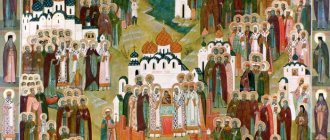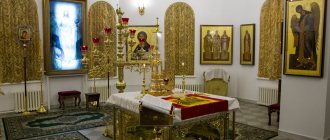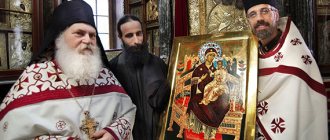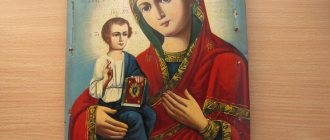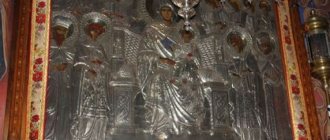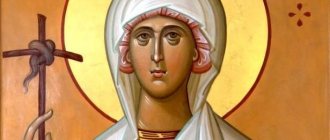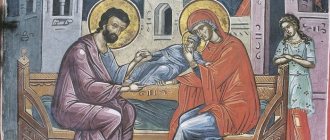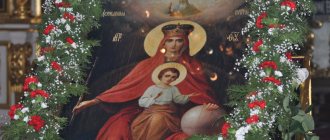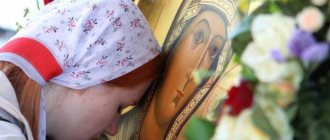In Orthodoxy there are a large number of icons of the Mother of God. Some of the holy images became famous for their miraculous properties: the ability to heal from wounds, both physical and mental, and to cure various diseases. One of the oldest miraculous shrines, which has become a spiritual refuge and protector for many, is the Novonikitsk Icon of the Mother of God. The history of the image goes back to the fourth century AD. e., confirmed her Divine power.
Origin of the icon
According to legend, in 372 the image appeared in a dream to the holy great martyr Nikita, one of the military leaders of the Gothic tribe, living in the territory along the banks of the Danube (present-day Romania). At this time, Byzantium was ruled by Constantine the Great, and Christianity was spreading in many countries.
A youth with a cross in his hand came to the martyr Nikita, a former warrior and disciple of the Gothic bishop Theophilus, in a dream. Upon awakening, the man began to reflect on the meaning of what he saw. Under the influence of God's revelation, the young Christian Juliana pointed to his chest. Looking, Nikita saw the image of the Most Holy Theotokos appearing on her chest, holding the Eternal Infant of God on her knees with a cross in her hand. The appearance of the holy image made a very strong impression on the man. Under its influence, he immediately converted to Christianity.
Soon, in the territory inhabited by the Gothic tribes (from the Vistula River to the Black Sea), Christians were subjected to severe persecution. By order of the Visigoth leader Atanaric, many Christians were brutally tortured and killed. One of the martyrs, sent to the stake after terrible torture, was the former military leader Nikita.
When the saint was led to execution, the image of the Mother of God that appeared to him was hidden under his clothes. The day of his martyrdom - September 28 (September 15, old style) became the day of celebration of the holy icon.
After the execution of the saint, one of his Christian converts, coming to the place of execution to bury the teacher, discovered that the body of the martyr had not been touched by fire. On his chest lay the image of the Mother of God, surrounded by radiance. The icon copied from it began to be called the “Novonikitsk Icon of the Mother of God.” The miraculous image of the saint and the subsequent copies made from it repeatedly proved the power of the Christian faith; believers were provided with protection from misfortunes and adversity.
It’s good to wash often: myths about shampoo and hair care that only harm
The money tree pleases with lush flowering: my secret is in caring for the leaves
Why French children behave well: eight ways to raise them
The suffering of the Mother of God near the Cross is the highest point of Her earthly sorrows. But they don't go unanswered
Holy Scripture, let us repeat this again, tells us almost nothing about the experiences of the Mother of God. We see Her at the Cross, and then near the Holy Sepulcher - but we can only guess about the depth of Her grief. The silence of the evangelists on this matter is filled by Church Tradition and, above all, by liturgical creativity. In particular, on Great Good Friday, when the entire Church mourns, remembering the death of the Son of God on the Cross, the canon of unparalleled beauty of the Canon sounds in churches - one of the components of the evening service. As a rule, the canon briefly describes the essence of the holiday or feat of the saint to which the coming day is dedicated. Simeon Logothetes is a Byzantine historian of the 10th century, the author of a chronicle of events that took place in Byzantium from 842 to 948. He is also considered the author of several prayers and liturgical works, in particular the Canon on the Crucifixion of the Lord and the lamentation of the Most Holy Theotokos by Simeon Logothet - a monologue of the Mother grieving for her Son.
Many of the thoughts that we have already expressed in this article are exactly what are heard in this canon. About the apostles who fled in all directions after the sudden night-time taking of Jesus Christ into custody:
“For the sake of the fear of the Jews, Peter hid himself, and all the faithful ran away, leaving Christ, the Virgin said weeping.” (“Out of fear of the Jews, Peter hid, and all the faithful fled, leaving Christ,” says the Virgin, sobbing.”)
Peter's denial. Rembrandt
About the tragic discrepancy between the joyful promise of the Angel on the day of the Annunciation - and everything that happened after:
“About Your terrible and strange Christmas, My Son, I was exalted above all mothers: but alas for Me, now seeing You on the Tree, my heart is on fire.” (“By Thy terrible and extraordinary Nativity, My Son, I was exalted above all mothers - but woe is Me: now I see You on the Cross, and it’s as if my insides are burning with fire.”)
About the unnaturalness of the death of the One who rules the whole world and Himself raised the dead:
“Your strange vision of the Lord carrying the whole creation is beyond the mind: for this reason Joseph, as if he were dead in his hand, carries and buries You with Nicodemus.” (“It is impossible to comprehend how You, the Lord, who holds the entire created world in your hands, is carried in your arms and buried as if dead by Joseph and Nicodemus.”)
About the anguish of a Mother who has lost her Son and desperately listens to the silence, waiting for an answer - what should She do next:
“Where are you going, Child, why are you making a rapid progress? food there is another marriage again in Cana, and there you are now trying to make wine for them from the water? Am I going with You, Child, or rather will I wait for You? give Me a word, the Word, do not silently pass by Me, keeping Me pure: for You are My Son and My God.” (“Where are you going, Child? Why are you hiding so quickly? Is there another marriage taking place in Cana? This refers to the event described in the Gospel of John. Christ with his Mother and disciples was invited to a wedding in Cana of Galilee, and when the hosts ran out of wine and guests It turned out there was nothing to treat them with, so at the request of the Mother of God, He created wine from plain water (John 2 :1-11).—Editor's note. Do you want to make wine for them again from water? Should I go with you, Child, or wait for you here? "Say a word to Me, O Word, do not pass by Me in silence, you who have kept Me pure! After all, You are My Son and God.")
And yet, the most wonderful thing in this canon is not the attempt to “reconstruct” the sorrowful feelings of the Mother of God, but the fact that Her monologue ultimately turns into a dialogue! Because in the final part of the canon we hear the answer of the Lord Himself:
“Oh, how has the abyss of bounties been hidden from You? The Lord said to the mother in secret, for although I wish to save my creature, I will die. But I will also rise again, and I will magnify You, as the God of heaven and earth.” (“How did the abyss of My bounties hide from You?” the Lord secretly said to the Mother. “Desiring to save My creation, I wished to die. But I will rise again and glorify You, for I am the God of heaven and earth.”)
The tears and prayers of the Mother of God do not remain unanswered. The Lord answers Her. And this is incredibly important.
Thesis 4.
Lists
One of the first copies created from this icon is kept in the Moscow Cathedral of the Most Merciful Savior near the Nikitsky Gate. Another list can be venerated in the temple of Istanbul, to which the relics of the Holy Great Martyr Nikita were transferred.
Another list takes pride of place in the iconostasis of the Church of the Great Martyr Nikita, built in the eighteenth century in the village of Sofyino (Ramensky district), on the banks of the Moscow River. You can also pray to the miraculous list in the Moscow Church of the Ascension of the Lord. The State Historical and Cultural Museum-Reserve of the Kremlin houses an icon painted in the seventeenth century by artists S. Ushakov and M. Milyutin.
Icon “Blessing of Children”: what it helps with
This relic has long served as a revered family amulet. In temples it was even placed on a special low lectern so that even very tiny children could approach the shrine. The image protects newborns, older children, teenagers, and boys and girls. He will protect your offspring from illnesses, injuries, temptations, disappointments, quarrels, bad habits and bad acquaintances, promote normal development and maturation, guide them on the right path, and warn against mistakes and sins.
The icon is also useful for parents - it will give empathy (the gift of sharing a child’s experiences and listening to his needs), patience, tact, the ability to cope with difficulties and misunderstandings, and a balanced combination of discipline, respect and love for the baby. In addition, the image brings harmony, peace and tranquility to the family - so it will be a welcome surprise for those who are just planning to acquire an heir.
It is known that a mother’s heartfelt prayer is a blessing to children. Therefore, bowing before the shrine, you can ask the Lord for your child’s happiness, prosperity, prosperity, good health, good mood and well-being. Your words will protect your baby from adversity, illness, insurmountable obstacles, and negative emotions.
The relic is often used to overshadow children who are facing some kind of challenge - admission to kindergarten, school, college or institute, long and difficult treatment, transfer exams, change of place of residence. The shrine is also used to bless the bride and groom, instructing them before marriage.
And the image will also be useful to everyone who is involved in raising or teaching children - nannies, coaches, teachers, lecturers and heads of various sections. By offering prayers to him, you will overcome the laziness, mistrust and apathy of the kids, find a common language with them, and instill in the children true Christian values.
Buying the “Blessing of the Children” icon is very simple - you just need to contact our manager to choose the work of the desired size, and soon a precious amber relic, handmade from radiant Polesie gems and small stone chips in strict accordance with Orthodox canons, will decorate your home!
Description of the museum exhibit
The Novonikit Icon of the Mother of God, kept in the Kremlin Museum, was created for the iconostasis of the Cathedral of the Savior Not Made by Hands in the Moscow Kremlin. The dimensions of the image are 111 x 76 cm. The technique of execution is tempera on gesso on wood. The color of the icon is composed of green, red, crimson and white colors with abundant splashes of gold. The icon uses the technique of conveying the wood texture of the Calvary Cross and the transparency of the robe of the baby Jesus, characteristic of the work of S. Ushakov and the iconographic style of many isographs of the Armory of the second half of the seventeenth century.
Rare shot: Viktoria Isakova showed her grown-up daughter from Yuri Moroz (new photo)
“We are still friends”: Derevianko commented on the breakup with his wife
A student at the Vietnam Police Academy shared how she takes care of her facial skin.
Iconography
The image belongs to the iconographic type of hodegetria. Its characteristic feature is the presence of a large cross in the hand of Jesus, which is a symbol of the Orthodox faith, as well as instruments of passion: a cane with a sponge and a spear.
A rather rare feature of the iconography of the image is that the Christ depicted on it is not a baby, but a youth. He is held on the lap of Our Lady. Jesus is crowned with thorns and dressed in a white robe trimmed with gold. With His left hand He grasped the spear. The Mother of God is dressed in a red chiton and a green maforium with a crimson lining, decorated with many stars, symbolizing the starry sky. The maforia border is decorated with gold ornaments with the inscription:
My soul magnifies the Lord, and my spirit rejoices in God my Savior, for He has despised the lowliness of His servant, for from now on all generations will bless me, for the Mighty One has done me greatness, and holy is His name (Luke 1:46-47).
The hands of the Mother of God are folded on her chest; with her right hand, the Saint points to the Son in a prayerful gesture. The crossed arms of the Mother of God symbolize reverence and humility, which, according to the Bible, represent the beginning of understanding and wisdom. The Holy Head is bowed towards the Son, and Her gaze is directed over His head, at the instruments of the Passion of Christ. The eyes of the Virgin Mary reflect all the strength of Her love for the Son of God and the sorrow due to the awareness of the trials ahead of him.
Slavic Baptists
(Ev. Luke 2, 22 - 35).
In the Gospel of Luke we find several stories that we will not find in the other three Gospels. Such stories are, for example, the story of Zechariah and Elizabeth, the annunciation to the Virgin Mary, the appearance of angels to the shepherds in the fields of Bethlehem, the conversion of Zacchaeus, the meeting of the risen Christ with the disciples going to Emmaus, as well as the story of Simeon and Anna.
What do we read about Simeon in the Gospel of Luke? “Then there was a man in Jerusalem named Simeon. He was a righteous and pious man, looking forward to the consolation of Israel; and the Holy Spirit was upon him.” We should be glad that amidst the deep spiritual darkness that reigned among the people of Israel in the days when Christ was born, there were some very bright lamps, and among them were Simeon and Anna. The thickest spiritual darkness reigned in Jerusalem, despite the fact that there was the greatest shrine of Israel - the temple.
On the simple, childish faith of Abraham, they piled “commandment upon commandment,” “rule upon rule,” “institution upon institution.” And all this was a human heap.
There was never a time in the history of mankind when our Lord did not have bright lamps on earth shining in a dark place, when He did not have living witnesses of His holiness, power and love.
We all know a very dark place on earth: Sodom and Gomorrah. But the Lord had a lamp there: it was righteous Lot. We like to call him a bad lamp, but the Word of God speaks of the righteousness of his soul. Let’s read 2 Peter 2:6-8: “And if, having condemned the cities of Sodom and Gomora to destruction, he turned them into ashes, setting an example for future wicked people, and delivered righteous Lot, tired of being treated by people who were furiously depraved (for this righteous man, living among them , I was tormented daily in my righteous soul, seeing and hearing lawless deeds).”
Take the home of King Ahab and his wicked wife Jezebel—isn’t that a dark place? But even in this dark place the lamp of God, the prophet Obadiah, shone.
Let's take Babylon - didn't the wonderful lamps of the Lord shine here with a bright light: Daniel, Shadrach, Meshach and Abednego? And in the dark spiritual night of the “beast,” will not the two witnesses of Christ, spoken of in Revelation 11, shine brightly?
Yes, righteous and pious Simeons filled with the Holy Spirit were on earth and will always be on earth, and the darker the spiritual night, the brighter their spiritual light shone and will shine.
Let us now listen to the words of Elder Simeon, when he took the Infant Jesus in his arms: “Now, Master, you are sending Your servant away in peace, according to Your word, for my eyes have seen Your salvation, which You have prepared before the face of all nations.” This is the only way to lose the fear of death and to leave this world in peace: to see the salvation of God in Christ Jesus. The Apostle Paul, having seen this salvation, that is, having come to know Christ as the Savior, also lost the fear of death and even called death gain. Here are his words. “To me to live is Christ, and to die is gain” (Phil. 1:21). Why acquisition? Because for a believer to die means: “to be resolved and to be with Christ” (Phil. 1:23). Some want to die, but why? Because they are tired of carrying their cross - illness, family troubles, particularly severe mental trauma, and so on. But a completely different matter is the look at the death of the Apostle Paul: “I have a desire to be resolved (that is, to die) and to be with Christ.” From the point of view of such desire, death is truly gain.
What an amazing testimony about Christ we hear from the lips of Simeon. Christ, says Simeon, is “the light to enlighten the Gentiles and the glory of Israel.”
"Light for the enlightenment of the pagans"! Yes, the pagan world was in terrible darkness. He worshiped “the work of his own hands.” Both Greece, and Rome, and the entire other pagan world lay in deep spiritual darkness, and in this darkness they yearned for the light, for the true light. But where will this light arise for them? Among their countless altars to the dead gods and various products of their hands, they also had altars to the “unknown God.” But how to recognize this “unknown God”? And then the light came in the face of Jesus Christ. And then the “unknown God” came to earth in the person of Jesus Christ. And the gospel message soon resounded throughout the pagan world, the message about Christ - salvation and the light of the world.
“The glory of Israel” - but, alas, Israel turned away, deliberately turned away from this glory in Christ, abandoning Him, their Messiah, and fell into disgrace among all the nations of the world. But Israel turned away from Christ only for a time. The Word of God says that the time will come when he will turn to Christ and Christ will become the “Glory of Israel.” Let's read Romans. 11, 25 - 26: “I do not want to leave you, brothers, ignorant of this mystery (so that you do not dream about yourself), that the hardening has happened in Israel in part, until the time when the full number of the Gentiles has come in, and so all Israel will be saved, as it is written: The Deliverer will come from Zion and will turn away wickedness from Jacob.”
Let us also listen to the prophetic words of Simeon about our Lord Jesus Christ: behold, this One is destined for the fall and rising of many in Israel and for the subject of controversy.”
Share this:
Liked this:
Like
Similar
How does an image help?
The Novonikitsk icon is asked for deliverance from physical and mental suffering. Those who are going on a long journey turn to her for support, especially if it involves risk. Those who wish to strengthen their faith and atone for unseemly deeds and sins also pray to the image.
Text of the prayer:
Accept, O All-merciful, Most Pure Lady Theotokos, these honorable gifts, bestowed upon You alone by us, Thy unworthy servants, chosen from all generations, who appear above all creatures of heaven and earth. Because for Your sake the Lord of hosts was with us, and through You we knew the Son of God, and became worthy of His Holy Body and His Most Pure Blood. Blessed are you, too, in the birth of births, God-blessed One, the brightest of the Cherubim and the most honest of the Seraphim. And now, All-Singing Most Holy Theotokos, do not cease praying for us, Thy unworthy servants, that we may be delivered from every evil advice and from every situation: and that we may be preserved unharmed from every poisonous pretext of the devil. But even to the end, through Your prayers, keep us uncondemned: for through Your intercession and help we are saved, we send glory, praise, thanksgiving and worship for everything in the Trinity to the One God and the Creator of all, now and ever and unto the ages of ages. Amen.
Found a violation? Report content
The earthly life of the Mother of God turned out to be a series of sufferings
When we think about the Mother of God, we somehow lose sight of this fact. We are accustomed to doxologies in Her honor, we are accustomed to calling Her “The Diligent Intercessor,” “The Most Honest Cherub and the Most Glorious Without Comparison of the Seraphim,” that is, the One who surpasses even the highest angelic ranks in honor and glory. But we absolutely do not remember the suffering - primarily mental, but also physical - through which this girl had to go through in order to become the One to whom we can turn with a prayer: “Most Holy Theotokos, save us!”
To begin with, imagine what happened to Joseph’s face when he found out that Mary, who was old enough to be his daughter, was pregnant. After all, Joseph and Mary were only called husband and wife, but in fact, She who was to give birth to Christ took a vow of virginity as a child and lived in Joseph’s house only because he promised to take care of Her and keep Her purity. They certainly could not have children - and yet Mary conceives a Child! The icon of the Nativity of Christ, among other things, depicts Joseph sitting in deep thought, and in front of him is an old man in goat skins. This old man is an allegorical image of the doubts and temptations that overwhelmed righteous Joseph. From the Gospel we know that, not wanting to publicly expose Mary of sin (as Jewish law required in the event of revelation of adultery), Joseph wanted to secretly release Her. He changed his mind after an Angel appeared to him and announced: Do not be afraid to accept Mary your wife, for what is born in Her is from the Holy Spirit; She will give birth to a son, and you will call His name Jesus, for He will save His people from their sins (Matthew 1 :19-21). And before that, Mary, of course, had to go through a very difficult moment associated with the doubts of Joseph, an honest and kind man...
The next episode that we find in the Gospel is the Nativity of the Baby Jesus itself. It does not happen at all in a comfortable hospital under the supervision of experienced doctors, and not even at home, where one could invite an assistant. Mary has to give birth in the most inappropriate conditions, immediately upon arriving in Bethlehem, where she and Joseph were forced to go to participate in the announced population census. The hotels in Bethlehem are all occupied, and travelers stop literally in the first place that comes their way, where in normal times cattle were kept, in fact, in a stable! Just imagine how any woman would feel in the place of the Mother of God and in Her position...
Mary and Joseph in the cave. Evgeniy Demakov
But now Christ is born, a little time passes - and Mary and Joseph urgently need to run, run without looking back along with the Newborn. And all because the Jewish king Herod, having learned from the magi about the birth of the new King of the Jews, sends an army to Bethlehem with a wild order: to beat (that is, kill, destroy. - Ed.) all the babies in Bethlehem and in all within its limits, from two years old and below (Matt 2:16 ). Flight to Egypt, probably full of hardships (there is a legend that along the way the Holy Family met two robbers and almost robbed them), life in a foreign land, wanderings in the desert and returning a few years later back to Palestine - all this was difficult both physically and morally.
And then we see how the grown Jesus seems to be increasingly moving away from His Mother and, in general, from the family in which He grew up. One day, when He turns twelve, Mother and Joseph lose Him while returning from a holiday in Jerusalem, and, naturally, they begin to worry terribly. Returning to the temple, they find the Boy sitting in a circle of scribes and experts of the Holy Scriptures and talking with them on equal terms. Child! What have you done to us? Behold, Your Father and I have been looking for You with great sorrow,” Mary calls out to her Son, and in response she hears the imperturbable: Why did you need to look for Me? or did you not know that I must be concerned with the things that belong to My Father? (Luke 2:48 , 49). Christ addresses the Mother respectfully, but does not justify himself at all. You can imagine what kind of parental feelings we would have in such a situation.
At the age of thirty, the Lord leaves home completely. From now on, He is a wandering Teacher, He has disciples, and He devotes all His time to them - and to thousands of other people seeking miracles from Him, and most importantly, healings. And Mother? Evangelists write very little about Her. So She and Jesus’ brothers (step-brothers, from Joseph’s first marriage, or cousins - Mary’s nephews, but definitely not relatives) approach the house in which the Savior is preaching, and, not daring to make their way through the crowd, ask to call Him to them, outside. When this request reaches the ears of Jesus, He answers: Who is My Mother? and who are my brothers? And pointing His hand at His disciples, He said: Here are My mother and My brothers; For whoever does the will of My Father in heaven, he is My brother, and sister, and mother (Matt. 12:48-50).
We cannot in any way suspect in these words of Christ disdain for his loved ones: and there could not be a shadow of disdain for the Mother in the heart of the One who, Himself dying on the Cross, was worried about Her future life and entrusted the care of the Apostle John (John 19 : 26 –27). Having said: here is My mother and My brothers, Christ only emphasized that everyone who wants to live according to the will of God becomes His family and friends. It is interesting that, from the point of view of dogmatic theology, in the sacrament of Baptism we really become related to Christ, we move from the category of creations God's in the category of His relatives... But what humility Mary must have had not to succumb to mundane parental emotions, not to imagine that the Son, to Whom so much strength, love and care was given, had become a stranger to Her! He is somewhere there, outside the walls of the house, surrounded by a curious crowd; and She is here, outside, with children who are not her own, lonely and confused... The Mother of God humbly accepts all this. As it will later become something else, much more terrible. The worst thing. Execution of one's own Son.
Sorrowful Christ with the Virgin Mary and John at the cross. author unknown
This execution took place right before Her eyes. Roman soldiers drove nails into the hands and feet of the Savior - and each blow tore the soul of His Mother, who stood near the Cross, exactly as Simeon the God-Receiver had once predicted. Almost all the apostles fled. At the Cross with the crucified Son stood only Jesus’ beloved disciple John, several faithful women (later they would come to the Tomb and be the first to know that Christ had risen) and His own Mother.
The Romans themselves, who invented the crucifixion, called this execution the most cruel and inhumane. Only runaway slaves and robbers were executed this way. And - God. Experiencing unimaginable torment, almost losing consciousness from pain, the crucified Lord nevertheless found the strength to turn to the Apostle John with a request to take care of His Mother. And this concern, born on the Cross, at the highest point of Calvary’s suffering, is in itself a powerful evidence of how She must have suffered in these hours...
And let us again summarize what has been said with the heartfelt words of Saint Innocent of Kherson: “Being destined for unparalleled greatness - to be the Mother of the Son of God, She, like Her Son, did not have on earth where to rest her head, crowned with thorns... In fact, think: during the time of fruiting to be a subject of terrible suspicion for the very guardian of His virginity; at the time of birth - do not have a place in the monastery and place the Baby in a manger. This means a feeding trough in a cattle pen. — Approx. ed.; in the temple, accept, along with a blessing, a weapon in the heart; then flee to Egypt; returning from there, live in poverty and misery in Nazareth; then to be a witness to slander and persecution of the Son; then - to stand on Golgotha: isn’t this the ladder of the cross reaching to heaven? And is it surprising if, walking along it faithfully and unceasingly, Mariam went further than the Cherubim and Seraphim? They have an ocean of light and flame of the Divine, but they do not have their own cross!”
Thesis 3.

